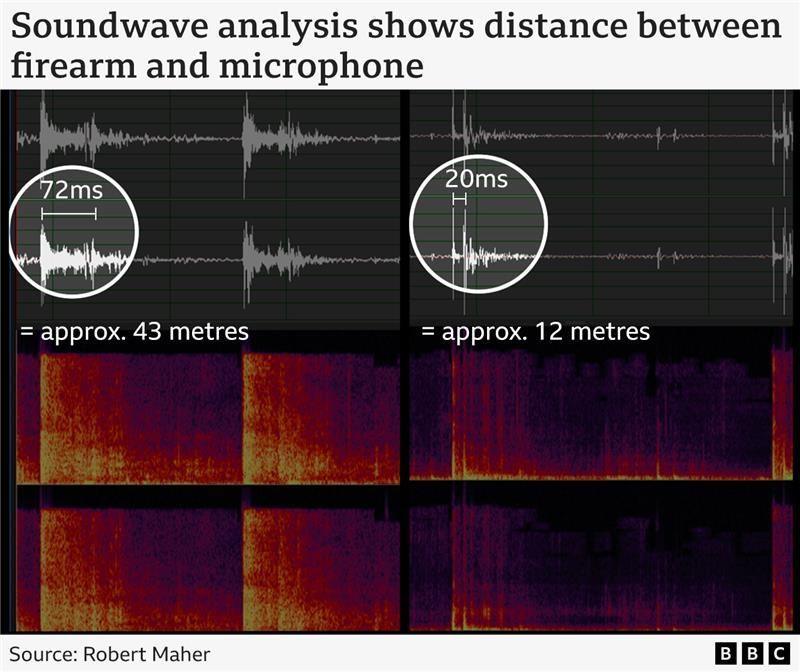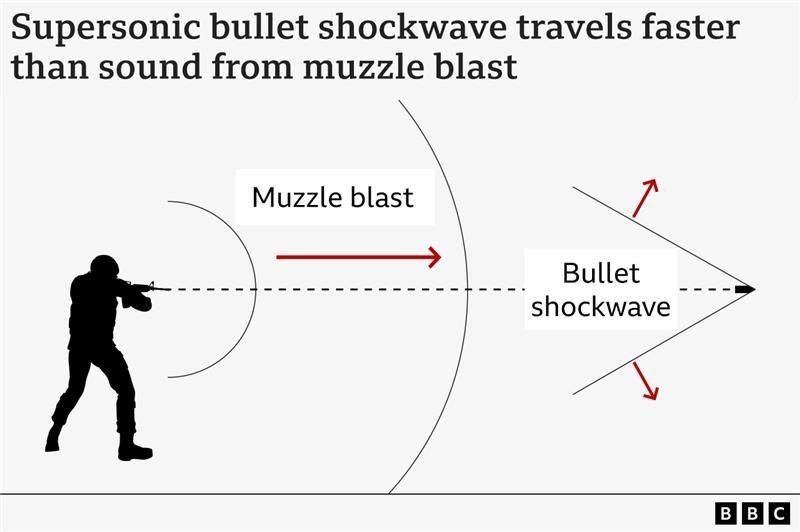Israeli army fired more than 100 shots in Gaza medics' killing, audio suggests
Gaza medics killing video analysed by BBC Verify
- Published
Israeli troops fired more than 100 times during an attack in which they killed 15 emergency workers in Gaza, with some shots from as close as 12m (39ft) away, a forensic audio analysis of mobile phone footage commissioned by BBC Verify has found.
Two audio experts examined a 19-minute video authenticated by BBC Verify, showing the incident and the moments leading up to it near Rafah on 23 March.
The findings support a claim made by the Palestinian Red Crescent that the workers were "targeted from a very close range". On 5 April an Israeli army official said aerial footage showed troops opening fire "from afar".
The Israel Defense Forces (IDF) declined to comment on the analysis directly when approached by BBC Verify.
A spokesperson said it was investigating the attack and repeated claims that six of the people killed were linked to Hamas, without offering evidence. The Palestinian Red Crescent rejected the allegation, as did a ninth paramedic who survived and was detained by the IDF for 15 hours.
The Palestinian Red Crescent said the full video was recovered from the phone of a medic killed and buried in a shallow grave by the IDF.
Video filmed by medic Rifaat Radwan who was killed in the incident showed the convoy driving at night, using headlights and flashing emergency lights. At least one medic can be seen wearing a high-vis jacket.
Faced with this, the Israeli army changed its account, admitting that its initial statement that the convoy approached "suspiciously" with its lights off was inaccurate.
Experts told BBC Verify they used sound waveforms and spectrograms to measure the distance of the gunfire from the microphone of the mobile. Shortened time gaps indicate that the distance between the microphone and the gunfire decreased as the video progressed.

They concluded that the first shots were fired from around 40m to 43m away. But towards the end of the video, gunfire came from around 12m away.
At a briefing on 5 April, an IDF official told reporters that surveillance showed the troops were at some distance when they opened fire, adding: "It's not from close. They opened fire from afar."
One military expert told BBC Verify that any engagements under 50m to 100m would be considered as being within close range.
Robert Maher, an audio forensics expert at Montana State University, said towards the start of the footage one firearm is discharged about 43m away from the mobile phone.
Mr Maher and another expert, Steven Beck, independently corroborated one another's view that in the final few moments of the audio, shots are fired as close at 12m away.
Mr Beck, a former FBI consultant who now runs Beck Audio Forensics, said: "The shooter(s) at these times is much closer, with distances of 12m to 18m. There is a strange pop sound that may be a tire hit by a bullet."
He added: "The shockwaves indicate that the bullets are passing close to the recorder microphone - meaning they are being shot at."
Chris Cobb-Smith, a former British Army officer with over 20 years experience in conducting investigations in conflicts zones, said that at 50m the Israeli troops would have "definitively been able to identify the convoy as humanitarian" and would have been able to "determine that the personnel were unarmed and not posing a threat".
Voices can also be heard towards the end of the recording, shouting in Hebrew: "Get up," and: "You (plural) go back".
Over the period of more than five minutes, at times, multiple firearms were in use simultaneously, the audio experts determined.
Mr Maher said "the sounds are often overlapping in such a way that it is clear multiple firearms are in use at the same time".
Because of the overlap of gunshots, Mr Maher said it's difficult to identify individual shots. But both experts determined independently that there were more than 100 shots.
Our audio analysts could not comment on which weapons were being used but Mr Beck said there are "several bursts of fully automatic gunfire".
How experts analysed the audio
A bullet travelling at supersonic speed first creates a sonic boom - often called a "crack". The sound of the bullet being fired is what creates a second sound, often called a "pop".
At close distances, the two sounds are almost indiscernible to the human ear.
But by looking closely at the waveform of the audio, the two sounds can be detected and the distance between them measured.
What Mr Maher describes as "crack-pop sequences" are visible in these waveforms.
Mr Maher said the further away the firearm is from the microphone, the longer the gap between the two sounds.

Mr Maher said: "The first few audible gunshots have a crack-pop timing of about 72ms. Assuming a bullet speed of 800 m/s and speed of sound 343 m/s, that time gap implies the firearm was about 43 meters away. If the bullet speed were actually faster, that would move the firearm estimate closer to the microphone."
There are limitations to their estimates. For example, analysts told us they cannot be certain of the type of firearm used or of the miss distance, which is how far off the shot is from the intended target. They also must make an assumption about the average speed of the bullet.
BBC Verify will continue to investigate this incident.
Additional reporting by Thomas Spencer.
